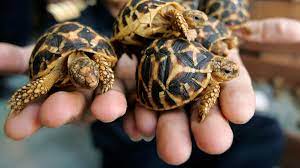Reptiles originate from hot, dry deserts or habitats with very specific requirements for their survival.
The species of Mediterranean tortoises originate from the countries surrounding the Mediterranean and the Middle East. Their natural habitat is grassland and shrub where there is a lot of sunshine and light shade. The most common species kept in the UK is the Hermann’s tortoise. Although other species such as the Spur-thighed and Marginated tortoise are kept. A species requiring generally similar husbandry in captivity is the increasingly popular Horsfield’s tortoise. Tortoises will grow annually in the right conditions and their shell scutes grow somewhat like the rings of a tree. Mediterranean tortoises can reach sizes in excess of 20- 25cm in some instances. Life expectancy up to 80 years or more under ideal conditions.
It is very important when considering whether to keep a reptile as a pet, that you understand what sort of controlled environment you will need to provide, and that you learn as much as you can about how to care for them beforehand. At PAWS we have the knowledge and expertise to guide you in caring for your reptile. On these pages we have provided some general information and guidelines about caring for the most popular reptiles, however, we advise that you come and visit us in the shop for a chat about your reptile's specific needs.
 The most common species of tortoise available in the UK is the Horsefield tortoise, the Hermann’s tortoise or the Spur-thigh tortoise. They can reach a size of around 20cm and have specific requirements regarding their care. You should also carefully consider their lifespan. Tortoises can live between 50 to 80 years, which is a long time to be responsible for a pet. If you do decide to opt for a tortoise and can provide all their requirements, they are ideal for the first-time keeper as they are hardy and do well in our climate.
The most common species of tortoise available in the UK is the Horsefield tortoise, the Hermann’s tortoise or the Spur-thigh tortoise. They can reach a size of around 20cm and have specific requirements regarding their care. You should also carefully consider their lifespan. Tortoises can live between 50 to 80 years, which is a long time to be responsible for a pet. If you do decide to opt for a tortoise and can provide all their requirements, they are ideal for the first-time keeper as they are hardy and do well in our climate.
Housing
Ideally your tortoise should have an indoor area and access to outdoors. Indoor accommodation: A purpose built enclosure (often called tortoise tables) are optimal, although large vivariums with good ventilation can also be used successfully, especially over limited time periods. The minimum cage size for an adult should be 90x30x40 cm for babies up to a 6cm carapace, rising to 2 square metres for adults but the bigger and more varied the habitat provided the more likely the tortoise is to do well. Outdoor accommodation: Tortoise should have access to escape proof outdoor accommodation whenever the weather is suitable. Ideally situated where there is natural non-toxic vegetation. Provide a basking area and opportunities to climb. All outdoor accommodation should be fox proof and a fully covered enclosure is essential for small tortoise to protect them from airborne predators.
Furnishing
 The floor of the cage should be covered with a suitable substrate such as, Coconut bark chips, Aspen wood shavings, Calci-sand or artificial grass – if using a product like Calci-sand it is recommended that a rich source of calcium is supplied so that the animals do not ingest too much of the substrate as a calcium source (resulting in possible gut impaction). Provide a shelter, perhaps with a piece of cork bark and additional bark or branches to create areas for climbing.
The floor of the cage should be covered with a suitable substrate such as, Coconut bark chips, Aspen wood shavings, Calci-sand or artificial grass – if using a product like Calci-sand it is recommended that a rich source of calcium is supplied so that the animals do not ingest too much of the substrate as a calcium source (resulting in possible gut impaction). Provide a shelter, perhaps with a piece of cork bark and additional bark or branches to create areas for climbing.
Heating
All reptiles are cold blooded and need an external heat source to maintain their body temperature. Each species requires different degrees of heating, but all will benefit from a range of temperatures within the indoor enclosure. One end should be heated. This creates a thermal gradient allowing the tortoise to choose its preferred temperature. Thermometers can be placed at each end to monitor the temperature range. The overall temperature should be controlled by a thermostat. Wire mesh guards should be fitted over all hot heat sources used in order to prevent thermal burns. Heat can be supplied by spotlights and/or UV heat lamps. Your pet shop will advise on heating products and their use suitable for your tortoise. Create a thermal gradient of 18-20°C at the cool end and 30-32°C at the hot end. Night temperature can safely be dropped to 18° or even a bit lower.
Lighting
Tortoises are diurnal and require strong UVB lighting to fully absorb and utilize the calcium in their diet. This light should be left on for 12- 14 hours in the day. The bulbs will need replacing from time to time and your pet shop will advise you.
Humidity
Maintain low levels of humidity. A damp habitat can increase the risk of breathing problems.
Cleaning
Remove droppings and uneaten food daily. Water and food bowls should be washed, dried and refilled daily. Vivariums should be completely cleaned out and disinfected with a pet-safe disinfectant regularly. Soiled substrate should be disposed of and replaced. Deodorisers can be used in the indoor enclosure - your pet shop will advise.
Diet & Feeding
Mediterranean tortoises are herbivores. Provide a varied high fibre diet low in fat and protein. Commercial pellets are available as part of a balanced diet and your pet shop will advise. Vegetables: Mixed vegetables and as many weeds and herbs such as, dandelion, groundsel, clover, sowthistle, etc. as possible – natural grazing in outdoor enclosures is ideal. Fruit: apples, berries, fresh and frozen (thawed), grapes, kiwi, pear, fed only occasionally in very small amounts since high sugar content in the diet is dangerous. A Calcium supplement and a separate multi vitamin should be added to the food provided. Fresh water should always be available.

Hibernation
his is a complicated procedure and you should ideally seek professional advice before you hibernate your tortoise., However before you consider hibernating your tortoise, it should be of sufficient size and weight and be showing no signs of illness to cope with the stress of hibernation. Your tortoise should be fasted for 2-3 weeks before hibernation (though fresh water must be provided). Your hibernation box should be well ventilated and be made of rat proof materials. The temperature should not fall below 2-3 C and not above 8C (optimum temperature is 5C). You should check your tortoise at regular intervals during hibernation. A reliable refrigerator set at the correct temperature can be ideal for this purpose.
Tortoises and the law
Mediterranean tortoises are protected by CITES regulations, all can only be legally sold (with the exception of the Horsfield’s tortoise), with a DEFRA Article 10 Exemption Certificate. They must be micro-chipped when big enough if being sold.
Shopping List
Indoor enclosure & provision for outdoor enclosure
Substrate
Heat mat/spotlight
UVB tube/UVB heat lamp
Thermometers x 2
Thermostat
Food and water bowl
Calcium supplement
Pet safe disinfectant
Cage furnishings
Vitamin supplement
Tortoise care book

